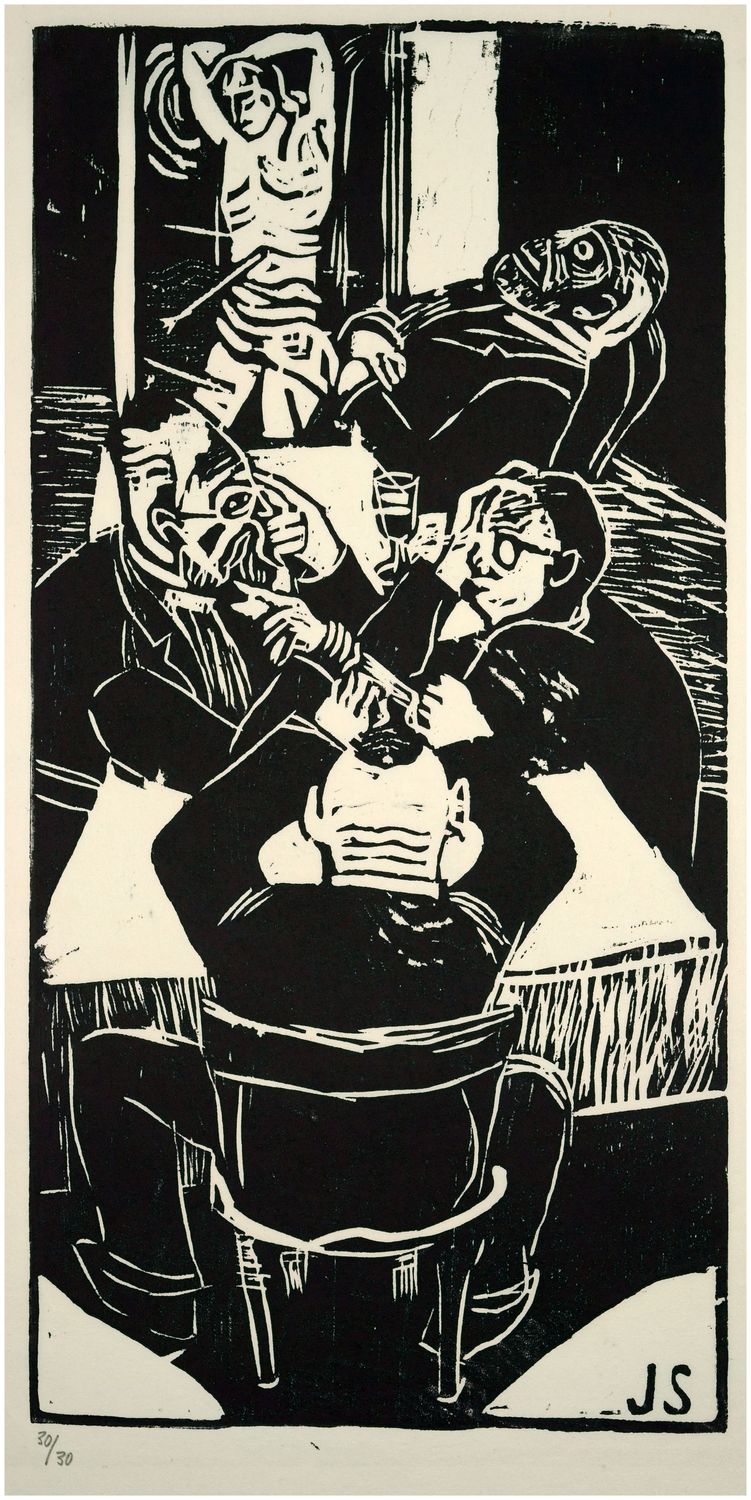Scharl, Josef (1896-1954), Mockery, 1935 (1964)
Josef Scharl(1896 Munich - 1954 New York), Mockery , 1935 (1964), Bronner 30 A. Woodcut on Japanese paper, 51.8 x 25.7 cm (image), 65 cm x 37 cm (sheet size), signed lower right in the printing block with the initials “JS”, identified lower left in lead as copy no. 30 / 30 and signed in lead by Alois Scharl on the reverse. This is a reprint from the original printing block made by Galerie Nierendorf in 1964.
- Slight creases in the left corners and mounting residue on the reverse, otherwise in excellent, fresh condition
- Desk Perpetrators -
At the end of a conference table that extends into the picture, St. Sebastian stands, pierced by arrows. In contrast to the people in suits, he wears only a loincloth, adding to the contrast with the "other" people. As desk-bound perpetrators, they have brought about the martyrdom with their "long-range weapons" and elevate themselves above the saint by completely ignoring him and the suffering they have caused and instead continuing with their usual actions. And yet the saint is the real protagonist of the image. He is approached by the white surface of the table, which appears as bright as Sebastian's body, while those seated at the table are dressed in dark clothes. His body and face also radiate a beauty that makes the ugliness of the perpetrators appear all the more striking.
Josef Scharl's large-format woodcut, created in 1935, reflects the approaching inhuman era of murder.
About the artist
In addition to training as a decorative painter, which he began in 1910, Josef Scharl attended evening classes in nude painting. After his military service from 1915 to 1918, he studied at the Munich Art Academy from 1919 to 1921 under Angelo Jank and Heinrich von Zügel. However, he turned his back on the academy and joined the Munich New Secession in 1923 and the artists' association 'Die Juryfreien' in 1929. During these years Scharl became a recognized artist, which was reflected in the awarding of the Dürer Prize of the City of Nuremberg (1929), the Rome Prize of the Berlin Academy of Art (1930), the Prize of the Munich Academy (1931), and the Förderpreis of the City of Essen (1932). The Rome Prize enabled him to spend extended periods in Rome and Paris from 1930 to 1932. As a member of the Deutscher Künstlerbund, he participated in its annual exhibitions from 1930 to 1936.
After the National Socialists seized power, Scharl's works were still shown in solo exhibitions at the renowned Neumann-Nierendorf Gallery in Berlin until 1935, but the artist was increasingly subjected to reprisals and emigrated to the USA via Switzerland without his family in 1938. He was motivated to do so by an invitation from the Museum of Modern Art to exhibit together with Max Beckmann, Georg Scholz, Erich Heckel and Karl Hofer.
In the USA, Scharl was supported by Albert Einstein, with whom he was on friendly terms and who wrote a memorial speech after the artist's death in 1954. In 1945, Karl Nierendorf published Scharl's first American monograph and presented his drawings in his New York gallery. Through Wolfgang Sauerländer, the artist illustrated the fairy tales of the Brothers Grimm for the publisher ‘Pantheon Books’. The book, published in 1944, enjoyed great popularity and led to further follow-up commissions. Josef Scharls became a US citizen in 1952 and died two years later.

